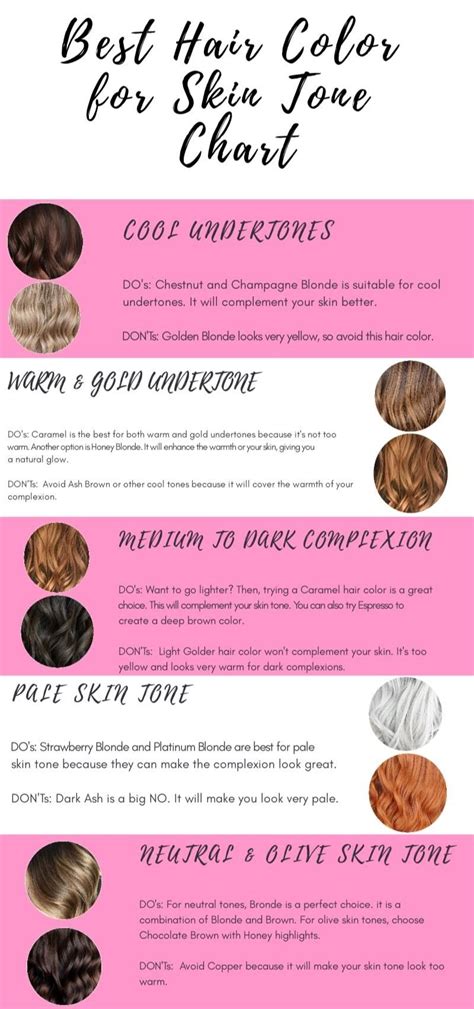Introduction:

Choosing the right hair color can transform your appearance, accentuating your features and enhancing your overall style. However, with so many options available, it can be overwhelming to navigate the vast spectrum of colors. To help you make an informed decision, we present you with the Best Hair Color for Skin Tone Chart – a comprehensive guide to finding the perfect hue for your skin’s unique undertone.
Understanding Skin Undertone:
The first step in selecting the right hair color is determining your skin’s undertone. This refers to the underlying color that determines the overall tone of your skin. There are three main undertones:
- Cool: Characterized by pink, red, or bluish hues
- Warm: Features yellow, golden, or peachy tones
- Neutral: A blend of both cool and warm undertones
To identify your undertone, examine your skin in natural light. If you have visible veins that appear blue or purple, you likely have a cool undertone. If your veins look more green or olive, you have a warm undertone. If your veins appear both blue and green, you have a neutral undertone.
Best Hair Color for Skin Tone Chart:
Once you have determined your skin’s undertone, you can refer to the following chart to find the most flattering hair colors:
| Skin Undertone | Best Hair Colors |
|---|---|
| Cool | Ash blonde, platinum blonde, silver, cool brown, burgundy, dark violet |
| Warm | Golden blonde, honey blonde, copper, caramel, warm brown, auburn |
| Neutral | Any hair color, both cool and warm tones will work well |
Tips for Choosing the Right Hair Color:
1. Consider Your Eye Color: If you have blue, green, or hazel eyes, cool hair colors will enhance their vibrancy. If you have brown eyes, warm hair colors will bring out their warmth.
2. Match Your Hair Color to Your Personality: If you are bold and outgoing, consider dramatic hair colors like red or platinum blonde. If you prefer a more subtle look, choose natural-looking shades like light brown or caramel.
3. Consult a Stylist: A professional hairstylist can help you determine the best hair color for your skin tone and face shape. They can also perform a strand test to ensure that the color you choose looks good with your natural hair.
4. Don’t Go Too Dark or Too Light: While it is tempting to opt for a drastic hair color change, it is important to choose a shade that complements your skin tone. Going too dark or too light can wash out your features or make them look too harsh.
5. Experiment: Don’t be afraid to experiment with different hair colors. You can try semi-permanent or temporary dyes to test out a new look before committing to a permanent change.
Effective Strategies for Maintaining Healthy Hair Color:
Once you have chosen the perfect hair color, it is essential to maintain its vibrancy and health. Here are some effective strategies:
- Use color-protecting shampoos and conditioners: These products help to prevent fading and protect your hair from environmental damage.
- Deep condition regularly: Deep conditioning treatments nourish and repair your hair, preventing damage and keeping it looking shiny and healthy.
- Minimize heat styling: Heat from blow dryers and flat irons can damage your hair and cause color fading. Use heat protectants and limit heat styling to special occasions.
- Get regular trims: Split ends can make your hair look dry and unkempt. Regular trims remove split ends and promote healthy hair growth.
Comparison Pros and Cons:
Permanent Hair Color:
- Pros: Lasts for several months, provides a more dramatic color change
- Cons: Can damage hair, requires regular touch-ups, can be difficult to remove
Semi-Permanent Hair Color:
- Pros: Fades gradually, less damaging than permanent color, can be touched up less frequently
- Cons: Does not last as long as permanent color, may not provide as vibrant a color change
Temporary Hair Color:
- Pros: Easy to apply and remove, does not damage hair
- Cons: Fades quickly, does not provide a permanent color change
Conclusion:
Finding the best hair color for your skin tone can enhance your beauty and boost your confidence. By following the tips and guidelines outlined in this guide, you can choose a hair color that complements your natural features and empowers your personal style. Remember to experiment, maintain your hair’s health, and consult with a professional stylist for personalized advice.
